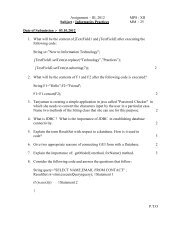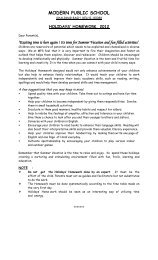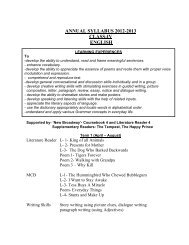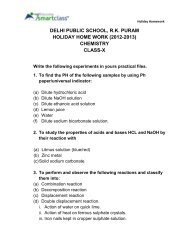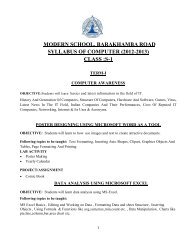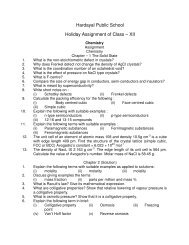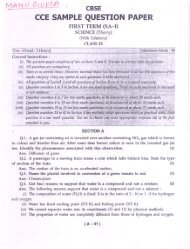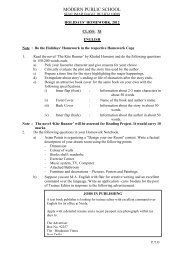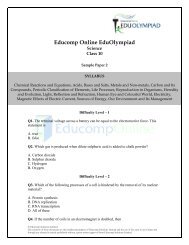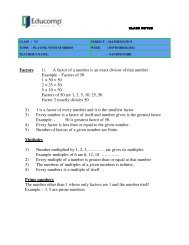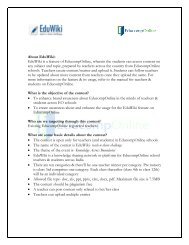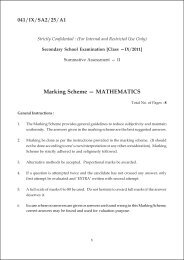Experiment V - Educomp Online
Experiment V - Educomp Online
Experiment V - Educomp Online
Create successful ePaper yourself
Turn your PDF publications into a flip-book with our unique Google optimized e-Paper software.
<strong>Experiment</strong> V<br />
AIM: To determine the major problem areas of the subject’s adjustment using the Adjustment Inventory<br />
for School Students (AISS)<br />
BASIC CONCEPT:<br />
1) Concept of adjustment (cbse.nic.in)<br />
a. Freud’s concept described mental health in terms of expressing oneself in love and work. A well<br />
adjusted person finds fulfillment on both aspe<br />
b. Erik Erikson’s concept: considered adjustment as the life long process which was the basis of mental<br />
health being mastery of crises at successive life stages.<br />
c. Maslow's concept: evaluated a well adjusted person whose goal is of self actualization.<br />
3) Stress, definition, sources (from text book)<br />
4) Promoting positive health and well-being (from text book)<br />
Methodology:<br />
. PRELIMINARIES–<br />
b. Name of Subject<br />
c. Age<br />
d. Sex<br />
e. General condition of subject<br />
f. Date<br />
g. Place of test conduction<br />
. MATERIALS REQUIRED<br />
a. AISS Manual<br />
b. AISS answer sheet<br />
c. Manual<br />
d. Watch<br />
e. Pencil<br />
f. Eraser<br />
. Description of test<br />
a. Name – Adjustment Inventory for School Students<br />
b. Author – AKP Sinha and RP Sinha<br />
c. Edition – 1951<br />
The inventory was designed in Hindi for use with Hindi-knowing students of India. The inventory seeks to<br />
segregate well-adjusted secondary students (ages 14-18) from poorly adjusted ones in the areas of<br />
Emotional, Social, and Educational adjustment.
A list of 100 questions indicating the significant problems of school students in the three areas was<br />
prepared. The questions are to be answered with a yes, or a no.<br />
Psychometric Properties.<br />
1. Reliability<br />
b. The coefficient of reliability was found by using the<br />
i. Split half method<br />
ii. Test retest method<br />
The coefficient of the test and subtest ranged between 0.90 and 0.96<br />
2. Validity<br />
a. The validity coefficients were determined for each item<br />
3. Standardisation<br />
a. Percentile norms were computed for both males and females in all 3 areas of adjustments separately<br />
and for the entire inventory. The subject can be classified into 5 categories with raw scores attained by<br />
them on the inventory.<br />
b. Categories are –<br />
i. Excellent<br />
ii. Good<br />
iii. Average<br />
iv. Unsatisfactory<br />
v. Very unsatisfactory<br />
4. The meanings of these scores are as follows –<br />
a. Emotional Adjustment – High scores indicate unstable emotions. Students with a low score tend to be<br />
more emotionally stable.<br />
b. Social Adjustment – Individuals scoring very high are submissive and retiring. Low scored indicate an<br />
aggressive personality.<br />
c. Educational Adjustment – Individuals scoring high are poorly adjusted with their curriculum and cocurricular<br />
programs. People with low scores are interested in school programs.<br />
. Process of Test Administration<br />
a. RAPPORT FORMATION AND INSTRUCTION – Copy from answer sheet.<br />
b. Precautions<br />
i. Aim of test must not be revealed<br />
ii. Room should be quiet and well-lit<br />
iii. Confidentiality of test results must be maintained<br />
iv. The statements must all be answered and none should be left out<br />
c. CONDUCTION<br />
i. The subject was brought to the laboratory and a rapport was formed.<br />
ii. Subject was made to feel comfortable.<br />
iii. The subject was asked to answer a set of questions, giving the first natural response.<br />
iv. At the end, the subject’s introspective report was recorded.
d. Introspective report:<br />
e. Behavioural Observation:<br />
. DATA – attached on facing page<br />
. SCORING<br />
i. The scoring can be done by hand<br />
ii. For every answer that indicates adjustment, a score of zero was given.<br />
iii. For every answer that does not indicate adjustment, a score of one is given.<br />
iv. The scores are added to get the raw scores.<br />
v. The total score indicates the subject’s general adjustment<br />
vi. The scores are interpreted using adjustment categories as implied in the manual.<br />
. RESULTS table – Make table on the facing page DIMENSION SCORE INTERPRETATION<br />
INTERPRETATION – Definition of Adjustment, Describe each area and give score, its interpretation<br />
and examples from the answer sheet, give overall score and explain level of adjustment.<br />
CONCLUSION:<br />
a. Using AISS, the subject was found to have ------adjustment levels.<br />
REFERENCES:<br />
a. NCERT Psychology for Class XII, AISS Manual



